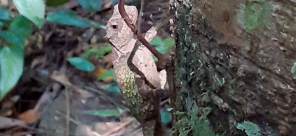Birds of Vietnam, Bird Species in Vietnam

Let's join AdventureGreen on our bird quests to learn about the different birds and bird species in Vietnam. Here you can find out more about the birding spots that these bird species are found.
- Order: Gruiformes
- Family: Rallidae
Poliolimnas is a genus of bird in the rail and crake family Rallidae.
Ancient Greek (poliós, “grey”).
Modern Latin limnas rail ( Greek limnas of the marsh > limne marsh).
1/ White-browed crake (Poliolimnas cinereus)
cinereus: Latin from cinis (ashes), meaning ashy grey.
Other names:
Porzana cinerea
Amaurornis cinerea
Porphyrio cinereus
- Order: Gruiformes
- Family: Rallidae
Rallina is a genus of bird in the rail and crake family Rallidae.
The genus name is feminine diminutive of Medieval Latin rallus (“rail”).
1/ Red-legged crake (Gà nước họng nâu, Rallina fasciata)
New Latin fasciatus means banded or striped.
2/ Slaty-legged crake or banded crake (Gà nước họng trắng, Rallina eurizonoides)
eurizon in Greek means Euro.
"-oides", "oida" is Greek or Latin for like, resembling, descendant of.
- Order: Gruiformes
- Family: Rallidae
Rallus is a genus of wetland birds of the rail and crake family Rallidae.
The genus name Rallus comes from the pre-binomial Latin name Rallus aquaticus for the water rail, but the exact etymology of the word is uncertain.
1/ Water rail (Gà nước Ấn Độ, Rallus aquaticus)
- Order: Gruiformes
- Family: Rallidae
Gallicrex is a genus of birds in the rail and crake family Rallidae.
The genus name combines the genus Gallus (From Latin gallus: “rooster, cock, male chicken") with the genus Crex (From Ancient Greek kréx, “corn crake”).
1/ Watercock (Gà đồng, Gallicrex cinerea)
cinerea is borrowed from Latin cinereus (“ashy”).
- Order: Gruiformes
- Family: Rallidae
Amaurornis is a genus of birds in the rail family Rallidae. The species in this genus are typically called bush-hens.
1/ White-breasted waterhen (Cuốc ngực trắng, Amaurornis phoenicurus)
The species name phoenicurus is from Ancient Greek phoinix, "red", and -ouros -"tailed".
Gruiformes, Gruidae: from the Latin word grus meaning "crane".
Rallidae: from rallus new Latin for rail, an aquatic bird.
Amaurornis: the Greek amauros, meaning "dusky" or "brown", and ornis, meaning "bird".
- Order: Gruiformes
- Family: Rallidae
Zapornia is a genus of birds in the rail family Rallidae.
The genus name is an anagram of the genus Porzana.
1/ Brown crake (Cuốc chân đỏ, Zapornia akool), or brown bush-hen
2/ Baillon's crake (Zapornia pusilla), also known as the marsh crake
This bird is named after French naturalist Louis Antoine Francois Baillon.
The names marsh crake and tiny crake have previously been used to refer to this species. pusillus is Latin for "very small".
3/ Band-bellied crake (Cuốc nâu, Zapornia paykullii)
4/ Ruddy-breasted crake (Cuốc ngực nâu, Zapornia fusca), or ruddy crake
5/ Black-tailed crake (Cuốc ngực xám, Zapornia bicolor)
Gruiformes, Gruidae: from the Latin word grus meaning "crane".
Rallidae: from rallus new Latin for rail, an aquatic bird.
- Order: Gruiformes
The avian family Rallidae, also known as rails, is a large, cosmopolitan family of small to medium-sized terrestrial and/or semi-amphibious birds of the order Gruiformes.
The family includes such ubiquitous species as the crakes, coots, and gallinule.
"Rail" is the anglicized respelling of the French râle, from Old French rasle. It is named from its harsh cry, in Vulgar Latin *rascula, from Latin rādere ("to scrape").
- Order: Charadriiformes
- Family: Turnicidae
Turnix is a genus of birds commonly known as Buttonquail or hemipodes of the family Turnicidae, of the order Charadriiformes referred to as shorebirds.
The genus name is an abbreviation of the genus Coturnix.
1/ Yellow-legged buttonquail (Cun cút chân vàng, Cun cút lưng hung, Turnix tanki)
resemble, but are unrelated to, the true quails.
2/ Barred buttonquail or common bustard-quail (Cun cút lưng nâu, Cun cút vằn,Turnix suscitator)
The specific epithet suscitator is Latin and means "awakening".
3/ Common buttonquail (Cun cút nhỏ, Turnix sylvaticus), also called Kurrichane buttonquail, small buttonquail, or Andalusian hemipode
The specific epithet sylvaticus is Latin meaning "of the woods" or "amidst the trees", sylva:'forest'.
4/ Little buttonquail (Cun cút bé, Turnix velox)
The genus name is an abbreviation of the genus Coturnix.
Turnicidae is from Turnix abbreviation from genus Coturnix, quail(Coturnix is the Latin for the common quail); coined to reflect the quail-like appearance and lack of hind-toe.
hemipodes: Greek hemi half, semi; podes from Greek pous, podos foot (Latin pes).
- Order: Charadriiformes
Buttonquail or hemipodes are members of a small family of birds, Turnicidae, of the order Charadriiformes collectively referred to as shorebirds.
Species of the Turnicidae resemble, but are not closely related to, the quails of Phasianidae.
The species of this family inhabit warm grasslands in Asia, Africa, Europe, and Australia.
Turnicidae is from Turnix abbreviation from genus Coturnix, quail(Coturnix is the Latin for the common quail); coined to reflect the quail-like appearance and lack of hind-toe.
hemipodes: Greek hemi half, semi; podes from Greek pous, podos foot (Latin pes).
- Order: Gruiformes
- Family: Heliornithidae
Heliopais is a genus of aquatic birds commonly known as the finfoots in the family Heliornithidae.
1/ Masked finfoot or Asian finfoot (Chân bơi, Heliopais personatus)
- Order: Gruiformes
The Heliornithidae are a small family of tropical birds with webbed lobes on their feet like those of grebes and coots. The family overall are known as finfoots, although one species is known as a sungrebe.
- Order: Gruiformes
The Gruiformes are an order containing a considerable number of living and extinct bird families, with a widespread geographical diversity. Gruiform means "crane-like": from Latin gruem, accusative of grus (“crane”).






































